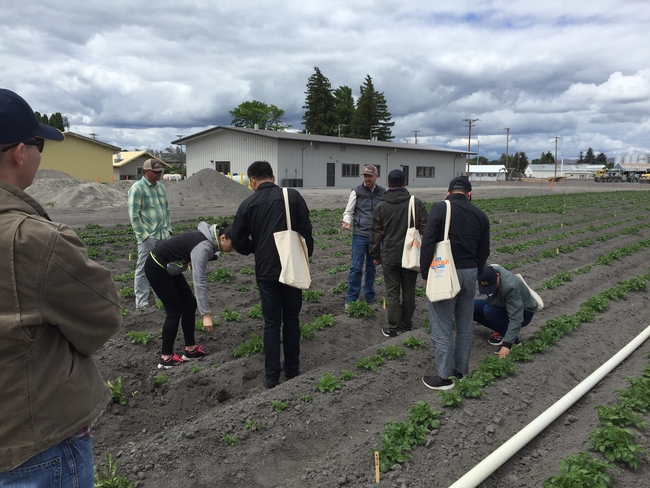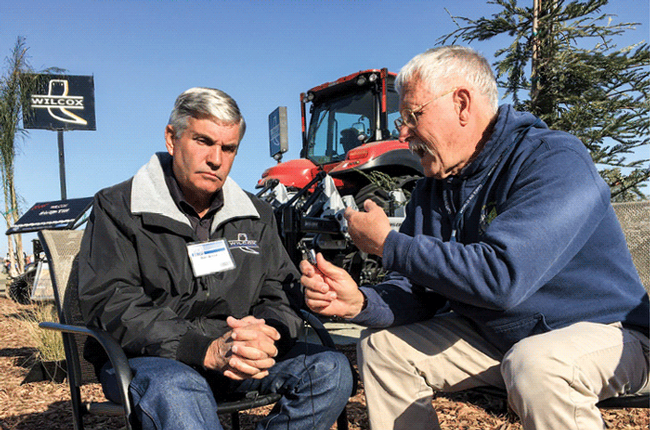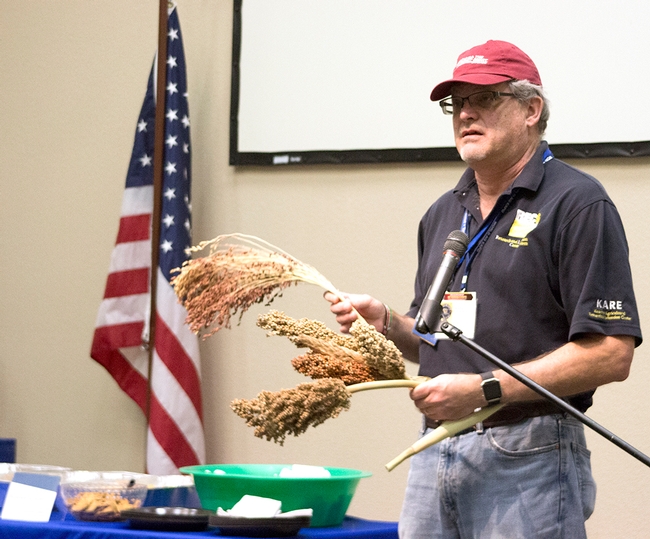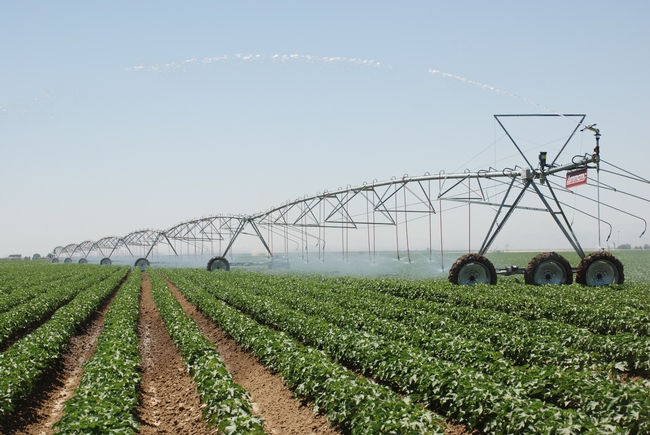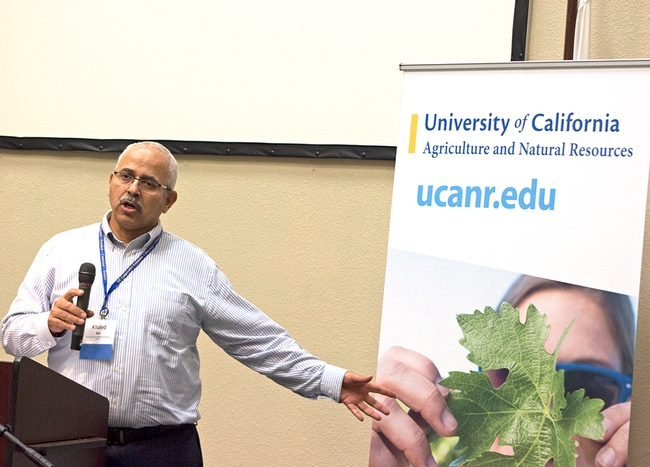Posts Tagged: Jeff Mitchell
June 2018 news clips
Agricultural advances draw opposition that blunts innovation
(Science) Anne Q. Hoy, June 29
Scientists are using technology to expand global food production and ease its environmental impact, but advances are being challenged by claims that lack scientific evidence and raise public distrust and concern, a leading agricultural scientist told an American Association for the Advancement of Science audience.
Alison Van Eenennaam traced the advent of campaigns against agricultural innovations related to areas from cattle and chicken production systems to plant biotechnology. The impact such efforts are having on agricultural advances was the focus of the ninth annual AAAS Charles Valentine Riley Memorial Lecture on 5 June at the AAAS headquarters in Washington, D.C.
http://science.sciencemag.org/content/360/6396/1413.full
UC Davis Experts Help Farmers, Ranchers Profit in Growing Trend
(Cal Ag Today) Patrick Cavanaugh, June 29
Many farmers could benefit from agritourism and the added value it brings, but developing successful agritourism operations can be tricky. Experts at the Agricultural Sustainability Institute (ASI) at UC Davis are helping farmers and others in the agricultural community understand the regulations, permits, insurance, marketing and other considerations needed to succeed.
“Agritourism operations are more successful when they're part of a supportive community of tourism professionals, county regulators, agriculture regulations and others,” says Gail Feenstra, ASI's food, and society coordinator.
Feenstra and her team recently received a $73,000 grant from Western Sustainable Agriculture Research and Education, a U.S. Department of Agriculture program, to develop training, resources and peer support for farmers and ranchers considering agritourism. Feenstra is working with Penny Leff, ASI's statewide agritourism coordinator and team project manager.
https://californiaagtoday.com/agritourism-california/
Green thumbs at the Marin County Fair
Wendy Irving, June 29
…UC Marin master gardeners is a group of more than 300 trained volunteers who work as non-paid staff members of the University of California Cooperative Extension. There are master gardener programs in 50 counties across California; our Marin group is one of the largest and most active.
http://www.marinij.com/article/NO/20180629/FEATURES/180629808
Answer to how urban coyotes thrive is not for weak-stomached
(Texarkana Gazette) From the LA Times, June 29
This scientific study is a coyote postmortem on an unprecedented scale—it has so far documented the contents of 104 stomachs and intends to examine 300 by the end of the year. The team, led by Niamh Quinn, UC Cooperative Extension's human-wildlife interactions advisor, is already generating a wealth of data to better understand how these omnivorous canids sample everything from pocket gophers to hiking boots while managing to survive in a land of 20 million people.
Mechanized vineyard saves labor, boosts quality
(Western Farm Press) Tim Hearden, June 27
Kaan Kurtural started working on a fully mechanized vineyard to help growers save on labor costs, but then he noticed it also produced grapes with superior quality.
“We made wine from these last year and compared it to our traditionally-farmed vineyards,” says Kurtural, a specialist in the University of California-Davis Department of Viticulture and Enology. “Until we tell people what it is, they can't distinguish the quality of the fruit or the wine.”
He demonstrated the 40-acre experimental vineyard during a recent field day at the UC-Davis Oakville Station north of Napa. About 200 winegrape growers, vineyard consultants, and other industry representatives attended.
http://www.westernfarmpress.com/grapes/mechanized-vineyard-saves-labor-boosts-quality
Several methods available to control vineyard weeds
(Western Farm Press) Tim Hearden, June 27
As most fumigants in California are being phased out, growers are having to find other ways to control weeds in young vineyards.
And while weeding by hand has been done, increased costs and a shrinking labor force have made this task impractical, says John Roncoroni, University of California Cooperative Extension Weed Science Farm Advisor in Napa County.
http://www.westernfarmpress.com/grapes/several-methods-available-control-vineyard-weeds
New podcast offers advice to California farmers
(Capital Press) Padma Naggapan, June 26
Two enterprising farm advisors with the University of California's cooperative extension have begun a podcast that will focus on tree crops and other produce grown in the Central Valley.
Called “Growing the Valley,” the podcast will have a new episode every two weeks, with each episode focused on news growers can use, such as managing specific pests, irrigation techniques, alerts about what to watch out for, and what tasks to take care of at particular times of the year.
http://www.capitalpress.com/Research/20180626/new-podcast-offers-advice-to-california-farmers
Proactive Pawnee Fire response in Lake County seeks to avoid another catastrophe
(SF Chronicle) Lizzie Johnson, June 25
“I've never seen so much focused attention in Sacramento on the issue,” said Keith Gilless, a professor of forest economics and dean of the College of Natural Resources at UC Berkeley.
“Last year, 2017, got everybody's attention,” said Gilless, chair of the California State Board of Forestry and Fire Protection. “Last year was just terrible. Everybody involved is doing their best to be as prepared as we can. Any area might burn now, including those with much higher structure densities than they did 20 or 50 years ago.
“You are going to need a lot of resources that you might not have needed before,” he said. “The state is being very aggressive in its suppression efforts.”
UC's Humiston welcomes visiting Chinese ag scientists
(Farm Press) Jeannette Warnert, June 25
UC Agriculture and Natural Resources vice president Glenda Humiston recently welcomed a delegation of Chinese agricultural scientists to UC ANR's Intermountain Research and Extension Center in Tulelake, reported Danielle Jester in the Siskiyou Daily News.
http://www.westernfarmpress.com/extension/ucs-humiston-welcomes-visiting-chinese-ag-students
With vineyard labor scarce, Napa growers warm up to machines
(Napa Valley Register) Henry Lutz, June 24
On a recent morning at the UC Davis Oakville Experimental Station, extension specialist Dr. Kaan Kurtural walked along the edge of an especially tall block of Cabernet Sauvignon.
Planted in 2016, the block hosts 1,340 vines and produces roughly 15 to 18 pounds of fruit per vine. “So it'll be yielding quite nice,” Kurtural said as he walked down the 62-inch tall rows.
Far more notable than the vineyard's fruit, however, is how it gets farmed.
“There are no hand practices out here,” said Kurtural. “Everything is done by machine.”
Early Detection Key to Managing Ceratocystis Canker in Almonds
(Growing Produce) Dianne Munson, June 22
...Based on a statewide survey out of the Department of Pathology at University of California, Davis, canker diseases are the primary cause of tree death in almond orchards, and Ceratocystis canker is one of the most prevailing canker diseases found in California. This canker disease is aggressive, but it doesn't have to mean disaster.
“If you know what to look for, the disease is manageable,” says Florent Trouillas, UC Cooperative Extension Specialist, Department of Plant Pathology, University of California, Davis.
California has 27M more dead trees than in 2016, but numbers may be easing in some areas
(Ventura County Star) Cheri Carlson, June 22
“Trees aren't getting moisture that they need to be healthy and they're stressed,” said Susan Kocher, a natural resources adviser for UC Cooperative Extension. “We had a huge insect outbreak because of the drought.”
Kocher, based in South Lake Tahoe, focuses on the Central Sierra, where stands of ponderosa pines were hit hard by beetle attacks.
…The highest risk of fire is when trees still have their needles – the so-called “red and dead” phase, Kocher said. Green needles turn red, and those dried-out needles are a particularly flashy fuel, like tinder in a campfire. Once the needles fall off, the risk drops a bit.
Chinese scientists visit Tulelake
(Siskiyou Daily News) Danielle Jester, June 20
The University of California Agriculture and Natural Resources Intermountain Research and Extension Center in Tulelake hosted a group of scientists from Chinese universities on Sunday; the scientists are on a tour of agriculture in northern California through June 22.
University of California Vice President of Agriculture and Natural Resources Glenda Humiston explained the purpose of the tour, noting, “The Chinese face many of the same issues that we do here in the U.S. The Chinese universities want to improve rural economic development to lift up the quality of life for people in rural communities.
“They are also responding to global climate change, drought and pests while trying to improve food security and water use efficiency. They see UC Cooperative Extension as an effective research model; we hope that scientific collaborations will accelerate solutions and help maintain relations for California agriculture with China.”
http://www.siskiyoudaily.com/news/20180620/chinese-scientists-visit-tulelake
It's summer. Here's how to preserve those fresh fruits and veggies
(San Luis Obispo Tribune) Rosemary Orr, June 20
June in San Luis Obispo County is a wonderful time to start preserving our summer bounty of fruits and vegetables.
The UCCE Master Food Preservers will teach the basic principles of food preservation and canning in its Introduction to Canning class on Saturday.
https://www.sanluisobispo.com/living/home-garden/article212766254.html
With wildfire season at hand, California on slightly safer footing this year
(SF Chronicle) Kurtis Alexander, June 17
… But as significant, and plentiful, as the new fire-protection measures are, they merely nip at the edge of an underlying issue: that fire is a constant in California, and as long as people choose to live in and around the state's wildlands, experts say, the threat remains.
"I would not be surprised if we have another big fire," said Bill Stewart, forestry specialist at the University of California, Berkeley. "I just don't think we're where we need to be."
… “We really haven't put together the pieces of a resilient fire strategy in local areas,” Stewart said.
https://www.sfchronicle.com/news/article/With-wildfire-season-at-hand-state-on-slightly-13000782.php
Reducing food waste to combat world hunger
(Morning Ag Clips) June 17
One-third of the world's food is spoiled or tossed rather than eaten, a fact that is tragic when nearly one billion people go hungry. The injustice of food waste is worsened by the fact that food decomposing in landfills emits greenhouse gases that contribute to climate change.
UC Cooperative Extension is working closely with the cities and county of Santa Clara in a far-reaching program to divert organic matter – food and green waste – from landfills by composting and using the product to enrich soil in the home garden.
https://www.morningagclips.com/reducing-food-waste-to-combat-world-hunger/
From dendrometers to drones, devices drive ag-tech boom
(Farm Press) Tim Hearden, June 16
Agriculture across the country is going high-tech, and California is leading the way as the tree nut and other industries are looking for ways to save water.
Agriculture across the country is going high-tech, as the ag and food sectors invested $10.1 billion in digital technologies in 2017, according to a University of California study. That's up from $3.2 billion in 2016, reports the UC's Giannini Foundation for Agricultural Economics.
In California, which was the leading state last year with $2.2 billion spent to adopt new technologies in ag and food production, UC Cooperative Extension researchers are researching or developing lots of new, innovative ideas. And growers are putting them to work in their fields and orchards.
http://www.westernfarmpress.com/technology/dendrometers-drones-devices-drive-ag-tech-boom
Santa Barbara County Avocado Farmer Struggles to Find Workers Amid Immigration Crackdown
(CNN Money/KTLA) Kristen Holmes, June 15
…“The crops that are most affected are the ones that use hired labor,” explains Daniel Sumner, director of the University of California, Agricultural Issues Center at UC Davis, pointing to avocados, berries and tree fruits. “It's really now through the rest of the summer that we're going to hear more and more farmers and farm workers rushing to get a harvest in with really not enough labor force to do it. And that's a real challenge. It may mean that we have crops rotting in the fields.”
http://money.cnn.com/2018/06/15/news/economy/california-farmer-workers-immigration/index.html
http://ktla.com/2018/06/15/santa-barbara-county-avocado-farmer-struggles-to-find-workers-amid-immigration-crackdown/amp
Research Nets Going Over Citrus Trees To Prevent Huanglongbing Disease
(Cal Ag Today) Jessica Theisman, June 15
Beth Grafton-Cardwell is the director of the Lindcove Research Extension Center in Tulare County and research entomologist based out of the University of California, Riverside. She recently told California Ag Today that there is work being done on installing a net structure to protect trees from Asian Citrus Psyllids, which spread the deadly Huanglongbing disease. Texas A&M researchers are installing net structures on the edge of groves to block psyllids from coming into an orchard.
https://californiaagtoday.com/research-nets-going-citrus-trees-prevent-huanglongbing-disease/
Overburdened growers fuel an ag-tech investment boom
(Western Farm Press) Tim Hearden, June 14
…While ag was slower than some other industries at adopting digital technologies, farm and food sector investments in these technologies zoomed to $10.1 billion nationwide last year, up from $3.2 billion in 2016, according to a new University of California report.
California was the leading state for ag-tech investments with $2.2 billion in 2017, or 22 percent of the total, and ag and food producers in the Golden State spent $5.1 billion on new technologies between 2012 and 2017, reports the UC Giannini Foundation for Agricultural Economics.
http://www.westernfarmpress.com/technology/overburdened-growers-fuel-ag-tech-investment-boom
UCD Oakville Field Day Highlights: Trellis Trials, Red Blotch Vector Update, Mechanization Tools
(Wine Business) Ted Rieger, June 12
The University of California, Davis (UCD) hosted its annual Grape Day at the Oakville Station experimental vineyard in Napa Valley June 6 with talks and presentations by UC Cooperative Extension specialists, and presentations and equipment demos from vineyard industry suppliers.
UCD viticulture extension specialist Dr. Kaan Kurtural showed a trial planted in 2016 with six different trellis systems designed for mechanical harvest in a 1-acre block at the experimental vineyard using Cabernet Sauvignon 08 on 3309 rootstock. The six trellis types include: a traditional vertical-shoot- positioned (VSP) trellis as a control; a single high-wire system designed for mechanized management; a high-quad system; a cane-pruned system with 12-inch cross arms for a sprawl-type canopy; and two versions of a relaxed VSP, one with a T-top post for a wider canopy.
https://www.winebusiness.com/news/?go=getArticle&dataId=199959
Local groups offer water measurement course
(Siskiyou Daily News) June 12
The Siskiyou County Cattlemen, Siskiyou County Farm Bureau and University of California, Cooperative Extension will sponsor a Water Measurement and Reporting Course in order to comply with Senate Bill 88.
http://www.siskiyoudaily.com/news/20180612/local-groups-offer-water-measurement-course
New Potato Varieties Displayed at Field Day in Kern County
(AgNet West) Brian German, June 11
Dozens of industry professionals took part in the annual Kern County Potato Variety Field Day where attendees got an opportunity to view new potato varieties and see the progress of ongoing growing trials.
“The potato field day in Kern County has a long history, it's been going on for generations essentially,” said Farm Advisor Emeritus with Kern County Cooperative Extension Joe Nunez. “It's an opportunity for the growers to see all the new varieties that are being developed throughout the country and see how they perform here in Kern County because our growing conditions here are a little bit different than where most of the potato varieties are being developed.”
http://agnetwest.com/new-potato-varieties-field-day-kern-county/
Debating California Tillage
(Farm Equipment) Alan Stenum, June 9
Despite differing opinions, Alan Wilcox, of Wilcox Agri-Products and Jeff Mitchell, no-till advocate at University of California–Davis, sat down during World Ag Expo in Tulare, Calif., to discuss the challenges and the opportunities for conservation tillage practices to take hold in California's Central Valley.
https://www.farm-equipment.com/articles/15683-debating-california-tillage
Letter: Residents get primer on fire preparedness
(Chico Enterprise-Record) Calli-Jane DeAnda, June 8
May was wildfire awareness month and the community participated in the wildfire safety fair at Lake Oroville Visitor Center on Saturday, May 19. At this fantastic event community members were able to get information about how to sign up for emergency notifications, access the evacuation preparedness plan, get wildfire recovery information and get tips for protecting homes from wildfire.
Kate Wilkin, UC Cooperative Extension, provided two presentations on prescribed fire and ways to protect homes from wildfire. Local fire-safe councils were there to answer the question: What does a fire-safe council do?
https://www.chicoer.com/2018/06/07/letter-residents-get-primer-on-fire-preparedness/
Why a Decline in Insects Should Bug You
(Wall Street Journal) Jo Craven McGinty, June 8
Entomologists want to put a bug in your ear: Insects are necessary for the survival of mankind.
“It's the classic third-grade food chain,” said Richard Redak, an entomologist at the University of California, Riverside, and co-author of the book “Bugs Rule!” “If you pull insects out, you've got a problem.”
…“Any organic product in a human's life probably has a beneficial insect and a pesty insect,” Dr. Redak said. “The pesty ones are an incredibly small fraction of the total. Those that are not a problem are critical to the ecosystem.”
https://www.wsj.com/articles/why-a-decline-in-insects-should-bug-you-1528467502
Brown Marmorated Stink Bug Officially Deemed Pest of California Almonds
(Growing Produce) David Eddy, June 7
Brown marmorated stink bug (BMSB) is certainly not new to California growers, but in the wake of some more troubling finds, it is now officially a pest of almonds.
Almonds are now listed as a preferred host on the Stop BMSB website, which was created by a team of researchers from all over the country dedicated to finding a way to stop the pest from damaging a wide range of crops.
One of those researchers is Jhalendra Rijal, University of California Cooperative Extension Area IPM Advisor for San Joaquin, Stanislaus, and Merced counties, who said the first such damage was just two years ago, when they were found in peaches. The actual first finding in the state was three years before that, in Sacramento, but despite being a very large find, they never appeared to spread, adding to the mystery of BMSB movement.
Visible smoke coming from UC field station burn
(The Union) June 7
Nevada County residents wondering why there is smoke in the air coming from our neighbors to the west today may be seeing smoke from a live fire training held by the University of California Cooperative and Extension at a field station in Browns Valley, according to Cal Fire spokesperson Mary Eldridge.
https://www.theunion.com/news/visible-smoke-coming-from-uc-field-station-burn/
UCCE advisors launch 'Growing the Valley' podcast
(Farm Press) Jeannette Warnert, June 5
A new UC Cooperative Extension podcast that focuses on growing orchard crops in the San Joaquin and Sacramento valleys is now available free at http://growingthevalleypodcast.com, Apple iTunes and Google Play Music.
The hosts are Phoebe Gordon, UCCE orchard systems advisor in Madera and Merced counties, and Luke Milliron, UCCE orchard systems advisor for Butte, Tehama and Glenn counties. The pair conduct research and extension programs that cover tree crops, with a focus on almonds, pistachios, walnuts, prunes, figs and cling peaches.
http://www.westernfarmpress.com/extension/ucce-advisors-launch-growing-valley-podcast
7 Highlights from the 2018 World Meat Congress
(Pork) U.S. Meat Export Federation, June 4
The 2018 World Meat Congress concluded Friday with sessions focused on consumer trends and education, as well as an in-depth look at cutting-edge technologies reshaping meat production around the world. The 22nd World Meat Congress was held in Dallas May 31 and June 1. Hosted by the U.S. Meat Export Federation (USMEF) and the International Meat Secretariat (IMS), the event drew about 700 participants from more than 40 countries.
…The panel featured Gary Rodrigue, blockchain food trust leader for the IBM Corporation; Dr. Martin Wiedmann, Gellert family professor in food safety at Cornell University; and Dr. Alison Van Eenennaam, cooperative extension specialist for animal genomics and biotechnology at the University of California-Davis.
… Van Eenennaam, whose program at UC-Davis focuses on research and education around the use of animal genomics and biotechnology in livestock production systems, explained the value of gene editing. For example, research is underway to utilize gene editing to prevent such diseases as African swine fever in hogs and tuberculosis in cattle.
“What better way to approach dealing with disease than through genetic improvement?” she noted.
https://www.porkbusiness.com/article/7-highlights-2018-world-meat-congress
Use of gene editing to introduce the polled trait into elite germplasm
(Progressive Dairyman) Alison L. Van Eenennaam and Maci L. Mueller, June 4
Physical dehorning of dairy cattle is a standard practice to protect both human dairy workers and other animals from injury. However, it is not only costly for producers, but also painful and stressful for the animals. As a result, dehorning is currently facing increased public scrutiny as an animal welfare issue. Despite these factors, 94 percent of U.S. dairy cattle producers report routine dehorning.
Early Ripening Grapes Could Revolutionize Raisin Production
(Growing Produce) Matthew Fidelibus, June 2, 2018
The USDA-ARS raisin grape breeding program has long focused on the development of early ripening varieties. Early ripening allows drying to begin sooner, thus helping to avoid inclement weather and enable production of dry-on-vine (DOV) raisins. ‘Fiesta' and ‘Selma Pete' are examples of early ripening raisin grapes from the USDA that have helped change the way California raisins are made.
http://www.growingproduce.com/fruits/grapes/early-ripening-grapes-revolutionize-raisin-production
UC ANR scientist debates conservation tillage practices with industry leader
Alan Wilcox of Wilcox Agri-Products and UC Cooperative Extension specialist Jeff Mitchell debated the challenges and opportunities for increased implementation of conservation tillage practices on California farms during the World Ag Expo in February, reported Alan Stenum in Farm Equipment magazine.
Wilcox said farmers are going to be resistant to anything they suspect will affect yield. Mitchell said creative innovation underway will have a big impact on some of the more challenging crops that are grown in California.
"This is a region where costs are high. The cost of doing business is high, and maximum yields on any crop are important to even break even," Wilcox said. "We're going to be intensely committed to water management and the maximum amount of water."
Mitchell said farmers in other parts of the U.S. started to switch to reduced disturbance no-till systems to conserve water.
"The recognition of the value of that opportunity to reduce soil water evaporation and have more water going through the crops through transpiration hasn't really sunk in here in California in large fashion," Mitchell said.
While Mitchell noted that water is essential to the discussion of conservation agriculture, there are other important aspects to consider.
"Biological cycling of nutrients in the soil, tightening up the system so there are fewer losses, either to the groundwater as some sort of pollution, or improving the overall soil function and nutrition provision capacity of the soil - that's not a small aspect of the overall system, nor are the opportunities for reducing costs," Mitchell said.
Wilcox said he would characterize the argument differently.
"The point is in all of our tillage strategies - and in every situation - we never compromise yield," he said.
Read the complete debate in Farm Equipment magazine.
More information about the use of conservation agriculture practices can be found on the UC Conservation Agriculture Systems Innovation website.
The drought may be over, but water concerns haven't been doused
Record winter rainfall during the 2016-17 winter has enabled farms to emerge from survival mode in the short term, but scientists are still working hard to be ready for the next drought, reported Tim Hearden in Capital Press.
Hearden spent a day at the UC Kearney Agricultural Research and Extension Center in Parlier to learn how researchers at the facility and the UC West Side Research and Extension Center near Five Points are combining technology with management practices to put every drop of irrigation water to work.
“This is one of the few places in the world where you can do drought research on a field level,” said Jeff Dahlberg, director of the 330-acre Kearney facility. “What I'm planning is a world-class drought nursery.”
At the West Side REC, researchers are working with farmers to perfect micro-irrigation efficiency and test drought stress on the area's most prevalent crops.
“We'll grow a tremendous number of cultivars of a crop” and identify “what seem to be the most promising cultivars when you grow them under drought conditions,” said Bob Hutmacher, a cotton specialist and the center's director.
Hearden spoke to Jeff Mitchell, UCCE cropping systems specialist and director of the Conservation Agriculture Systems Innovation center (CASI). CASI is encouraging farmers to adopt farming practices that save water, reduce dust and help improve the condition of soil, such as subsurface drip irrigation, overhead irrigation, minimum tillage, cover crops and crop residues.
“This is not done right now in California,” Mitchell said. “In the future, there may be a strong likelihood of certain agricultural sectors adopting these practices.”
Other subsurface irrigation trials are showing dramatic increases in yields. Khaled Bali, an irrigation water management specialist at Kearney, said underground drip systems in alfalfa fields have achieved 20 to 30 percent more yields while in some cases using 20 percent less water.
Kevin Day, a UCCE pomology advisor in Tulare County, is trying subsurface drip in a peach and nectarine orchard after working with the USDA to use it for pomegranates. He's seen as much as a 90 percent reduction in weeds because there's no surface water to feed them.
“Fewer weeds, fewer pesticides,” he said. “We use high-frequency irrigation. We irrigate as the crop needs it. When you do that, you keep the roots deeper, which makes for better aeration.”
State funding may help farmers overcome challenges to improved soil practices
Improved soil promises to help farmers use less water and reduce carbon in the atmosphere, reported Ezra David Romero on Valley Edition, a one-hour weekly program that airs on KVPR-FM.
The five-minute story, which begins at the 30:30 mark, focuses on CDFA's new Healthy Soils Initiative. The program is expected to allocate $7.5 million for farmer incentives to use practices that will improve soil health and reduce greenhouse gas emissions. These are practices that are already in place on some innovative valley farmers, including two that are active in the UC Agriculture and Natural Resources' Conservation Agriculture Systems Innovation center.
Jesse Sanchez, manager at Sano Farms in Firebaugh, said 15 years ago, tractors were rolling across the 4,000-acre tomato farm all the time. Now, the farm features cover crops in the winter, reduced soil tillage, irrigation with super-efficient buried drip tape and lower fertilizer needs. The result is a one-third drop in water use and a 75 percent reduction in diesel to fuel tractors, Romero said.
Many of the farm's tractors have been sold. "We don't want to see them no more," Sanchez said.
Retired Madera County farmer Tom Willey discussed the critical importance of soil care he learned as a long-time organic vegetable grower.
"It's the survival of our species," Willey said. "The soil is the thin skin of the earth that we all exist on. Our lives are bound up in the health and productivity of the soil."
UC Cooperative Extension specialist Jeff Mitchell noted the challenges that farmers face in making soil care changes. “A real part of the challenge for California farms is the high-value nature of the production systems, the crops themselves, and some difficult challenges in terms of the diversity of the crops," he said.
Overhead irrigation holds water-saving potential for California farms
In California, 40 percent of agriculture is still irrigated by pouring water onto farmland, a much less efficient practice that drip and overhead irrigation. But those numbers are changing, reported Matt Weiser on Water Deeply.
Weiser interviewed UC Cooperative Extension cropping systems specialist Jeff Mitchell about the water-saving potential of using overhead irrigation, a system that is popular in other parts of the nation and world, but only used on 2 percent of California farmland. Mitchell was the primary author of a research article in the current issue of California Agriculture journal, which said that water and money can be saved using overhead irrigation in production of wheat, corn, cotton, onion and broccoli.
Mitchell said California researchers are looking more closely at overhead irrigation because they anticipate future constraints on agriculture, including water and labor shortages. Additionally, the system is ideal for combining with conservation agriculture systems, which include the use of cover crops, leaving crop residue on the soil surface and reducing tillage disturbance of the soil. The combination of overhead irrigation and conservation agriculture practices reduces water use, cuts back on dust emissions, increases yield and improves the soil.
Weisner asked how overhead irrigation could be as efficient as drip, when people typically see "water spraying everywhere from these roving sprinklers high off the ground."
Mitchell said farmers use pressure regulators and a variety of nozzles on hoses hanging down from the system to deliver water at precisely the rate and location where it is needed through the season.
"So, they're not spraying water. These are low to the ground, and there are various delivery nozzle practices that can be used," Mitchell said.

